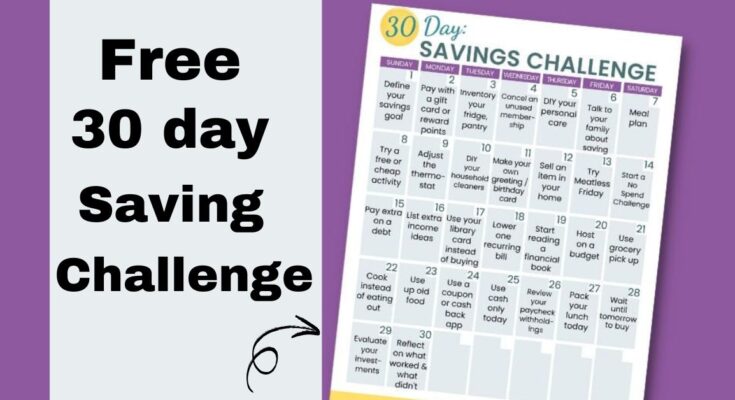Saving money doesn’t have to be complicated. Whether you’re trying to build an emergency fund, save for a big purchase, or just gain better control over your finances, a structured 30-day money-saving plan can help you achieve your goals.
This step-by-step plan will help you cut unnecessary expenses, develop better spending habits, and boost your savings—without feeling deprived. By the end of 30 days, you’ll be amazed at how much you’ve saved and how much more mindful you are about your financial habits.

Here’s Complete 30-day action plan
How This 30-Day Plan Works
This money-saving challenge is designed to help you:
✔️ Reduce unnecessary expenses
✔️ Build better spending habits
✔️ Save more money without major sacrifices
✔️ Identify and eliminate financial waste
✔️ Gain confidence in managing your finances
Each day will introduce a small yet effective financial task that will bring you closer to your savings goal. Follow along and see just how much you can save in one month!
Week 1: Assess & Plan Your Finances

Day 1: Set a Clear Savings Goal
Decide how much you want to save in 30 days. Whether it’s $500, $1,000, or more, having a target will keep you motivated.
Day 2: Track Your Expenses
Write down everything you spend money on for one full day. Awareness is the first step to cutting unnecessary costs.
Day 3: Cut 3 Unnecessary Expenses
Review your spending and eliminate at least three non-essential expenses. This could be subscription services, dining out, or impulse purchases.
Day 4: Switch to Cash-Only for a Week
Withdraw a set amount of cash for the week and only use that for daily expenses. This prevents overspending with credit or debit cards.
Day 5: Create a Realistic Budget
Now that you’ve tracked your expenses, set a monthly budget for essentials like rent, food, transportation, and savings.
Day 6: Automate Your Savings
Set up an automatic transfer from your checking account to your savings account. Even just $10–$20 per week can make a difference.
Day 7: Have a No-Spend Day
For one full day, don’t spend money on anything except absolute necessities. It’s a great way to reset your spending habits.
Week 2: Smart Shopping & Spending

Day 8: Use Cash Back Apps
Download and use apps like Rakuten, Fetch Rewards, or Ibotta to earn cash back on groceries and shopping.
Day 9: Make a Grocery List & Stick to It
Plan your meals and create a shopping list before going to the store. Avoid impulse purchases and only buy what you need.
Day 10: Buy Generic Instead of Brand Name
Choose store-brand products instead of name-brand. They are often just as good but can save you 20–30% on groceries and household items.
Day 11: Cancel Unused Subscriptions
Check your bank statement for any subscriptions you’re not using (gym, streaming services, apps) and cancel them.
Day 12: Meal Prep for the Week
Cook meals in bulk and prepare your lunches for the week. This will cut down on dining out and food waste.
Day 13: Use Coupons & Discount Codes
Before making any purchase, search for promo codes and coupons. Websites like Honey and RetailMeNot can help you save.
Day 14: Swap Out a Paid Activity for a Free One
Instead of going out for entertainment, opt for free activities like hiking, picnics, or free local events.
Week 3: Reduce Bills & Cut Costs

Day 15: Lower Your Utility Bills
Turn off lights when not in use, reduce thermostat settings, and unplug devices to lower electricity costs.
Day 16: Negotiate a Better Rate on Your Bills
Call your internet, phone, or insurance provider and ask for a better deal or discount. Many companies offer loyalty discounts if you ask.
Day 17: Sell Unused Items
Declutter your home and sell clothing, electronics, or furniture on Facebook Marketplace, eBay, or Poshmark for extra cash.
Day 18: Pack Your Own Snacks & Drinks
Avoid spending money on coffee, sodas, or snacks by bringing them from home.
Day 19: Use Public Transport or Carpool
If possible, take the bus, bike, or carpool instead of driving to save on gas and parking costs.
Day 20: Start a Side Hustle
Look for a simple side hustle like freelancing, dog walking, or online tutoring to increase your income.
Day 21: Review Your Insurance Policies
Check if you can get a cheaper insurance policy or bundle services for better savings.
Week 4: Stay Committed & Build Long-Term Habits
Day 22: Set Up a “No-Spend Weekend”
Challenge yourself to spend nothing except for necessities over the weekend.
Day 23: Switch to a High-Yield Savings Account
Move your savings to a high-yield account to earn more interest on your money.
Day 24: Try a DIY Project Instead of Buying
Before buying something new, see if you can DIY it—this works great for home decor, gifts, and repairs.
Day 25: Set a Weekly Spending Limit
Decide how much you’re allowed to spend per week and stick to it.
Day 26: Reevaluate Your Goals
Look at how much you’ve saved and adjust your future financial goals.
Day 27: Invest Small Amounts
Use an investing app like Acorns or Robinhood to start investing small amounts automatically.
Day 28: Cook a Fancy Dinner at Home Instead of Dining Out
Instead of spending money at a restaurant, cook a special meal at home and enjoy the savings.
Day 29: Set a Savings Challenge for Next Month
Plan your next money-saving challenge, such as a no-spend week or increasing your savings goal.
Day 30: Celebrate Your Progress!
Look at how much you’ve saved and reward yourself (without breaking the budget!).
Final Thoughts: Start Your 30-Day Savings Challenge Today!
By following this 30-day money-saving plan, you’ll develop better financial habits and see real progress in your savings. Even small changes can lead to big results over time.
Now it’s your turn! Are you ready to start your money-saving journey? Let us know in the comments how much you plan to save this month! 🚀💰


